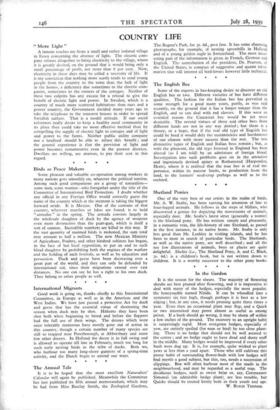In the Garden
It is the season for the shears. The majority of flowering shrubs are best pruned after flowering, and it is imperative to deal with many of the hedges, especially the most popular, the honeysuckle named Nitida. It can be wheedled into a symmetry six feet high, though perhaps it is best as a low edging ; but, in any case, it needs pruning quite three times a year. Even then an occasional plant may flop, and a Quick or two intermixed may prove almost as useful as among privet. If a bush should go wrong, it may be shorn off within a few inches of the ground. The recovery to an upright habit is surprisingly rapid. Most evergreen hedges, especially of yew, are entirely spoiled (for man or bird) by too close plant- ing. There is no hedge that should not be well aerated to the centre ; and no hedge ought to have dead and dusty stuff in the middle. Many hedges would be improved if every other bush were dug up. It is, for example, quite wicked to plant yews at less than a yard apart. Those who still cultivate this pretty habit of surrounding flower-beds with low hedges will find myrtle a good subject, but this, too, needs a succession of clippings. Box will often harbour most of the snails in the neighbourhood, and may be regarded as a useful trap. The deciduous hedges, such as sweet briar or, say, Cotoneaster Simonsii (an admirable hedge plant), are less trouble, but Quicks should be treated firmly both in their youth and age.
W. BEACH THOMAS.








































 Previous page
Previous page